The single-movement sonata form was the supreme type of instrumental music in the Classic era, although Classic composers themselves apparently shared no general concept of the internal organization therein.1 Only in the Romantic period did the term "sonata form" acquire in conventional usage a more specific meaning as a structure of three sections—Exposition, Development, and Recapitulation—each of which was supposed to comply with a fixed pattern of thematic presentation.2
The basic fallacy in this traditional Romantic approach lies in its excessively broad application, and especially in its attempt to impose retrospectively such specificity on music of the Classic period. As an abstract concept, the Classic sonata form resists the imposition of preconceived patterns, retaining instead a significant degree of flexibility. Furthermore, a description of the Classic sonata form in thematic terms is unsatisfactory, because thematic elements are not necessarily the decisive factors. From its inception to the end of the Classic period, the sonata form retains only two constant factors, both of which are tonal: the Exposition modulates at some point from the tonic to a second key level, and the Recapitulation includes a reappearance of the tonic key. Thus the Exposition customarily divides into two tonal areas, the first centered on the tonic and the second on another key, usually the dominant. The subsequent return to the tonic normally coincides with the arrival of the Recapitulation, although these two events are not inevitably concurrent. Hence sonata form provides two primary points of modulation, one away from the tonic and one toward the tonic, both of which are often effected by means of bridge passages. The interjection of bridges, then, occurs most commonly between the first and second tonal areas of the Exposition and immediately before the onset of the Recapitulation.
Such bridges generally perform either a transitional or a retransitional function. In the following discussion, the term transition refers to a passage that appears either between the first and second tonal areas of the Exposition or at the corresponding point within the Recapitulation. Retransition as defined herein is a passage that precedes the arrival of the Recapitulation. Such a passage may evolve during the later stages of the Development, serving ultimately as the final point of tension before resumption of the tonic.
* * *
In Mozart's works, the structure of any bridge depends largely on its fundamental purpose within the total design. This purpose may range from simple fulfillment of a modulatory requirement to substantial expansion of the tonal or thematic framework. In some instances, the bridge may achieve nothing more than a terse modulation. On other occasions, the bridge may travel a less direct route from one key to another, often enlarging a motivic or thematic element by sequence or imitation. From time to time, the bridge may even assume a developmental function; a number of motivic or thematic units may appear in conjunction with a shifting tonal base. In any event, the bridge, as a passage joining two structural elements, virtually never attains total autonomy—a state that would create a section independent of its flanking elements and therefore incapable of serving as a bridge.
Mozart's transitional passages between the two tonal areas of the Exposition offer a wide diversity of patterns. Some of these Expositional transitions are no longer than a single measure and function only as vehicles of modulation. They often restate no more than the head motive of the first theme, sometimes preserving only its rhythmic shape. Alternately, supplementary figuration arranged in stepwise or arpeggiated patterns may be employed. At any rate, such transitions, because of their brevity, rarely include contrapuntal or sequential enlargement.
Most of Mozart's transitions, however, go far beyond this elementary type of design to achieve a structural significance unprecedented except perhaps in the works of Haydn and J.C. Bach.3 Usually Mozart modulates by a circuitous route from the first to the second tonal area, progressing through one or more intermediate key centers. In order to preserve a smooth tonal linkage with the end of the first area, the transition normally retains the tonic level for a brief span before initiating modulation. Yet now and then the transitional process commences with an unprepared change of key or mode, thereby producing a disruptive rather than a connective effect. Transitions launched in this manner are often exceptionally rich in tonal and thematic content. In many cases, they open in either the relative or the parallel key and modulate eventually to the dominant, as in the first movement of the Piano Sonata in F major (K. 332). The first tonal area, as shown in Example 1, closes in measure 22 with an authentic cadence in F major.
Example 1. K. 332/I, meas. 20 ff.
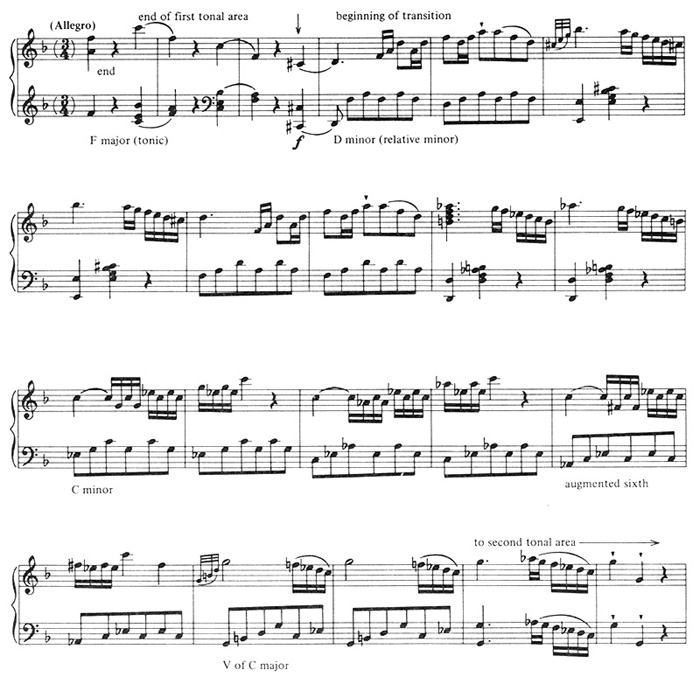
Instigating the transition is a bold linear modulation; the notes C-sharp and D-natural are sounded successively in vertical octaves to implant the key of D minor. Thence the tonality shifts to C minor and passes through an extended augmented-sixth sonority before arriving on the dominant of C major, the key of the second tonal area.
Most Expositional transitions, like the above example, lead sooner or later to an open cadence on V of the approaching key. Transitions cadencing on I of the forthcoming tonality are relatively infrequent, probably because of the resulting implication of tonal completion. While an open (or half) cadence on the dominant tends to generate a sense of something to follow, a cadence on the tonic implies harmonic fulfillment. Thus an open cadence provides a more logical transitional outcome, since, as we have noted, autonomy is not conducive to transition.
In a large majority of cases, Mozart heightens structural unity by relating the material of a transitional passage to some other portion of the design. Often elements belonging to one or both tonal areas furnish the entire content of an Expositional transition. In general, transitions deriving material from both tonal areas are the result of specific formulas used to shape the Exposition. This type of transition usually intervenes between tonal areas that are themselves thematically allied. The second tonal area, for example, may open with a new thematic member but conclude with a recall of the head motive of the first tonal area. Accordingly, the first theme may contribute to the materials of both tonalities, while the second theme belongs exclusively to the second principal key level. By superimposing a tripartite thematic design over a bipartite tonal scheme, Mozart achieves the type of structural elision illustrated in Figure 1. Within many Expositions based on this particular formal plan, the transitional passage preceding the second tonal area exhibits elements derived from the first theme but excludes any reference to the second theme. Thus the materials of such a transition may emanate from a single thematic source, but one attributive to both tonal areas.
Figure 1
EXPOSITION
| FIRST TONAL AREA | SECOND TONAL AREA |
| first theme | second theme | first theme |
Well over half of Mozart's transitions that include material from both tonal areas conform to the above description. Less frequently, transitions of this type occur within other Expositional designs. Sometimes Mozart introduces the second tonal area with the same theme that prevailed in the first, thereby delaying the initial appearance of the second theme, if any. As outlined in Figure 2, such a technique creates within the Exposition another type of structural elision.
Figure 2
EXPOSITION
| FIRST TONAL AREA | SECOND TONAL AREA |
| first theme | first theme | second theme |
This type of design was favored more by Haydn than by Mozart, although it is far from rare in the sonata movements of the latter composer.4 Because thematic change does not coincide with tonal change in such designs, the need for transitional intervention before the second tonal area is diminished, and Mozart occasionally excludes transitions altogether in Expositions of this nature. When transitions do appear in this context, the elements therein are likely to include supplementary material as well as the head motive of the first theme. By injecting supplementary material at this point, Mozart avoids what could otherwise become excessive and possibly tedious accentuation on a single motivic unit.
When the Exposition includes thematically contrasting tonal areas, the intervening transition is likely to derive material from only one of them. If, then, the transition is based on the first tonal area alone, the second area normally omits reference to previous elements in order to concentrate on new material. Such a transition commonly enlarges the head motive of the first theme, but in occasional instances material from the end of the first thematic group may predominate. In either case, the transition becomes a quasi-development, relating to the first tonal area in much the same way that a full Development section traditionally relates, on a larger scale, to the entire Exposition.
Among Mozart's sonata movements, any transition is more likely to recall than to anticipate. Consequently, Expositional transitions based exclusively on material from the second tonal area are uncommon. Perhaps Mozart preferred to complement the tonal freshness of the second area with a corresponding newness of thematic elements. In those relatively few transitions dependent on the second area alone, the anticipated material is almost never part of the second theme itself. Indeed, a far more common subject of transitional anticipation is the closing theme, as in the first movement of the Piano Sonata in G major (K. 283). Following the close of the first tonal area on the opening beat of measure 16, the transition proceeds with sequential treatment of an ascending figure reinforced by octaves, as shown in Example 2a.
Example 2a. K. 283/I, meas. 16 ff.

Well into the second tonal area, at measure 43, this figure re-emerges as the nucleus of the closing theme (Example 2b).
Example 2b. K. 283/I, meas. 43 ff.

Sometimes the Expositional transition includes no overt connection with the materials of either tonal area, but relates instead to some other portion of the movement. Occasionally an introduction prior to the Exposition may supply the contents of transition, but more often these contents are associated with a segment of the Development. As an alternative, the Expositional transition may relate to other bridge passages—to the retransition before the Recapitulation or, of course, to the correlative transition within the Recapitulation.
* * *
As noted earlier, the sonata form of the late eighteenth century is flexible in many respects, although the tonal duality of the Exposition is a constant element. The first and second areas, regardless of their occasional thematic interdependence, always retain contrasting tonal identities. The necessity to modulate before the second area of the Exposition often generates a transition, but no corresponding necessity exists before the second area of the Recapitulation. Yet even in the absence of mandatory modulation, Mozart rarely omits transitional activity at this point. Whereas the Expositional transition effects a change of key, its counterpart in the Recapitulation serves instead to revitalize the existing tonality. In the first instance, then, the tonic key is dissolved, while in the second it is renewed.
Thus the transitions of Exposition and Recapitulation achieve contrasting tonal results but almost always display similar constituent materials. In fact, some transitions within Recapitulations are virtual duplicates, either transposed or untransposed, of their earlier correlates. Particularly in his youthful works, Mozart is likely in the Recapitulation to restate the initial transition untransposed, thereby producing an exact copy of the original. In such instances, both transitions usually lead to an open cadence on the dominant, which in the first case takes on a tonic function to establish the new key center, but which in the second case retains its function as V to preserve the original tonic level. Consequently, as illustrated in Figure 3, this type of transitional cadence is of a tentative nature, permitting more than one subsequent harmonic direction.
Figure 3
| EXPOSITION | RECAPITULATION |
| FIRST AREA |
TRANSITION | SECOND AREA |
FIRST AREA |
TRANSITION | SECOND AREA |
| tonic | open cadence on V |
V becomes I of new key |
tonic | open cadence on V |
V remains as dominant of tonic key |
In his middle and later works, Mozart is more likely to restate the materials of an Expositional transition intact but in transposition. Frequently, in the Recapitulation, the closing harmony of the first area is inflected toward the subdominant, so that the ensuing transition recalls the materials of its earlier model at the fourth above or the fifth below.
Quite often the transitions of Exposition and Recapitulation resemble each other in general dimensions but diverge in certain particulars. Either singly or in various combinations, elements such as rhythm, melodic contour, harmony, or, in ensemble movements, instrumentation may undergo permutation. Almost never does permutation of a given element or elements extend through an entire transition; rather, such permutation is usually intermittent, involving only portions of the transitional passage.
Frequently, for instance, transitions of Recapitulation, in relation to their Expositional forerunners, manifest three successive stages: one of untransposed or transposed recall; one of melodic, harmonic, and/or rhythmic alteration; and one of transposed recall. On occasion the first of these stages is omitted, so that the later transition introduces some sort of alteration immediately. Sometimes rhythm and instrumentation emerge as fixed elements amid melodic and harmonic variation, as in the first movement of the Symphony in A major (K. 201). Shown as Examples 3a and 3b, the transitions of Exposition and Recapitulation both commence with a common rhythmic motive in the violins  , accompanied by quarter-note motion in the lower strings.
, accompanied by quarter-note motion in the lower strings.
Example 3a. K. 201/I, meas. 27-32 in Exposition.
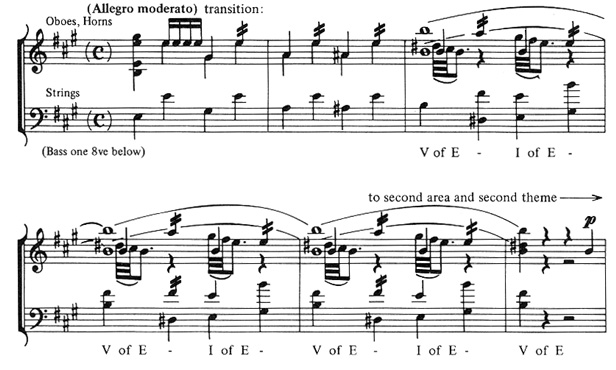
Example 3b. K. 201/I, meas. 133-138 in Recapitulation.
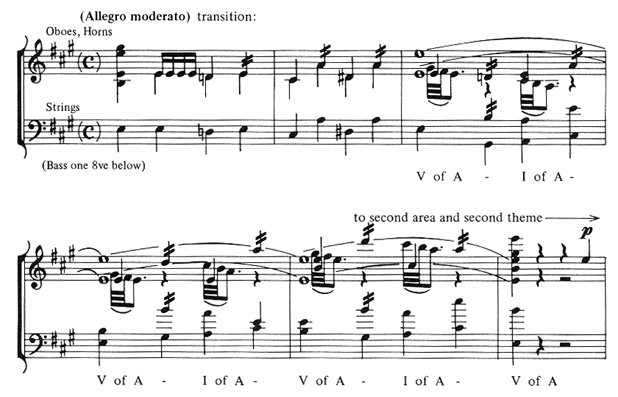
At the same time, these opening measures exhibit harmonic and melodic diversities. After the first area cadences on the dominant, the Expositional transition (measures 27-32) progresses to V of E major, the forthcoming tonality of the second area. The later transition (measures 133-138) also succeeds an open cadence on the dominant, but its harmonic destination is V of A major, the tonic key, which continues through the remainder of the movement. Except for their different tonal levels, the two transitions are alike during their concluding measures.
Since the obligatory modulation of the Exposition does not pertain to the Recapitulation, the Classic composer could—and sometimes did—condense the later transition with little difficulty. However, Mozart follows such a procedure in surprisingly few movements, often choosing instead to increase the dimensions of the second transitional passage.5 In this respect, Mozart anticipates Brahms, who sometimes replaces the Development section by a greatly enlarged transition between the two areas of the Recapitulation.6
Frequently Mozart introduces the transitions of Exposition and Recapitulation in the same manner, but shortly thereafter the later transition proceeds to expand the contents of its predecessor before closing with transposed restatement. Thus the unmatched measures within the second transition are flanked on either side by portions of restatement. On occasion, nevertheless, the unmatched segment launches the later transition—a pattern which occurs, for instance, in the first movement of the Symphony in G minor (K. 550).7 As indicated in Figure 4, the transitions of Exposition and Recapitulation extend from measures 28 to 43 and 191 to 226 respectively.
Figure 4
| K. 550/I: TRANSITIONS IN EXPOSITION AND RECAPITULATION |
| Transition in Exposition (16 measures in length) |
Transition in Recapitulation (36 measures in length) |
| | | | |
meas. 191-197, E-flat major: false recall in transposition of meas. 28-33 |
| | | | |
meas. 198-203, F minor: false recall in transposition of meas. 28-33 |
| | | ý |
meas. 204-210, modulatory: sequential extension of preceding material |
| meas. 28-33, B-flat major: antecedent phrase of contrasting period |
meas. 211-216, G minor: true recall in transposition of meas. 28-33 |
| meas. 34-43, V of V to V of B-flat major: consequent phrase of contrasting period plus cadential extension |
meas. 217-226, V of V to V of G minor: true recall in transposition of meas. 34-43 |
The segments spanning measures 191-197 and 198-203, both of which reproduce the ingredients of measures 28-33 but at contrasting tonal levels, emerge in retrospect as false recalls. Only at measure 211 does the true recall of the Expositional transition begin; measures 211-226, in fact, constitute a transposed replica of measures 28-43.
Transitions belonging to the Recapitulation, then, usually display some element of reference to their earlier counterparts. But often these transitions perform a developmental as well as a recapitulative function, thereby becoming fundamental components of the overall design.8
* * *
Unlike transitional passages, which either modulate from one key to another or revitalize the existing tonality, retransitions share a common tonal objective: preparation for the return of the tonic key. Situated at the second of the two essential points of modulation in sonata form, the retransition to Recapitulation often becomes the climactic element of the entire movement. In its pivotal location, this passage may constitute at once the final stage of ever increasing harmonic tension and the primary vehicle of ultimate resolution.
Because of its fundamental purpose in the Classic sonata design, the retransition achieves a significance unparalleled in the works of previous stylistic eras. In Baroque music, partially because a strong cadence in the tonic was often withheld until the closing measures, the techniques of development and simple recall habitually intermingled, sometimes to the point of virtual fusion. This fusion, for the most part, obviated the need for retransitional linkage of any consequence. For different reasons, the retransition was also to play a less vital role in much nineteenth-century music. Tonality in the Romantic period had become too fluid to sustain the Classic equilibrium between harmonic tension and resolution.9 The actual moment of return to the tonic, which for the Classic composer had provided the main opportunity for the release of tension, became in the Romantic era little more than a perfunctory gesture. Indeed, the nineteenth-century composer often sought, by various devices, to negate any sense of resolution engendered by the return of the tonic. Hence the retransition in the Romantic century lost its former critical position between elements of tension and release.
Ultimately, tonal preparation for the Recapitulation constitutes the only essential component of retransition in the Classic sonata form. Nevertheless, the procedures enlisted to obtain such preparation show almost unlimited diversity. Frequently Mozart initiates these procedures in gradual stages, especially after an appreciable Development section, so that designation of any precise location as the beginning of retransition becomes at least partially subjective.10 Most retransitions, like their transitional counterparts, are continuously composed, although palpable phrase and period constructions appear from time to time.
Retransitions in Mozart's sonata movements exhibit a rich variety of harmonic patterns. As the traditional gateway to the tonic, the dominant normally plays a significant role in effecting restoration of the initial tonality. Sometimes, in fact, dominant harmony of the approaching key may furnish virtually the entire tonal substance of a retransitional passage, as illustrated in Example 5.
By contrast, many retransitions emerge in a tonality other than the dominant, later progressing to V of the tonic with the approach of the Recapitulation. Such a pattern requires two essential stages—one of modulation and one of confirmation. During the modulatory stage, which normally involves the opening segment of re-transition, the tonality is deflected from the departing key toward V of the forthcoming tonic. Once achieved, this harmony is eventually confirmed by the inevitable resolution with the arrival of Recapitulation. In some retransitions, the stage of modulation is commensurate in length to the stage of confirmation, but frequently these two stages receive unequal emphasis.11
Often the Development enters retransition through the relative or the subdominant tonality. Either key may modulate easily to the tonic, but Mozart generally chooses a deliberately roundabout path of tonal change. Intermediate progressions may include extended chromatic passages, which normally occur within the context of sequential enlargement.
Almost all retransitions approach the Recapitulation via V of the tonic. Mozart abandons this scheme in very rare instances and then only in his later works. Set in C major, the second movement of the String Quartet in F major (K. 590) provides a relevant illustration. The Development closes on the first beat of measure 60 with an open cadence on V of the relative minor. This harmony ( -
- -
- ), which is also the mediant-made-major of the tonic key, continues during the first two measures of the retransition, as shown in Example 4.
), which is also the mediant-made-major of the tonic key, continues during the first two measures of the retransition, as shown in Example 4.
Example 4. K. 590/II, meas. 60 ff.
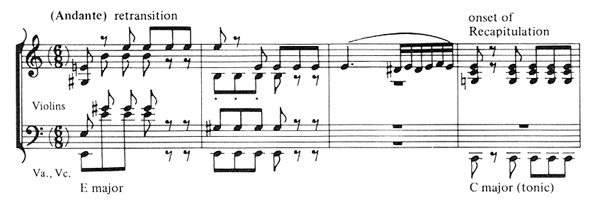
Thereafter, only the root, E-natural, surrounded by embellishing tones, remains to effect linkage with the Recapitulation, which opens on I of the tonic key. Retransitions bypassing V of the tonic altogether were to become increasingly common in the Romantic period as tonal relationships assumed greater fluidity. Even such early nineteenth-century composers as Beethoven and Schubert sometimes exclude the dominant during retransition, particularly if the Recapitulation commences with a sonority other than I of the central key. Yet in Mozart's works, and for that matter in the music of the Classic era as a whole, a retransition without dominant harmony is extremely rare.
On occasion, a retransition between Development and Recapitulation provides little more than the necessary preparation for resumption of the tonic. In many cases, however, Mozart expands the role of retransition to include substantive development of various materials. With few exceptions, these materials relate to at least one other portion of the movement, thus binding the retransition more firmly to the remainder of the design. Retransitional materials emanate from a variety of sources, which often, but certainly not always, involve one or both of the principal thematic groups.
Retransitions related to both tonal areas of the Exposition usually belong to movements in which these areas are thematically allied (see Figures 1 and 2 above). Shown as Example 5 is the retransition in the first movement of the Piano Trio in D minor (K. 442). The fragment stated in turn by the left hand of the piano, the cello, and the violin  is the head motive of the initial theme, prominent throughout the first areas as well as in the closing portion of the second area.
is the head motive of the initial theme, prominent throughout the first areas as well as in the closing portion of the second area.
Example 5. K. 442/I, meas. 150 ff.
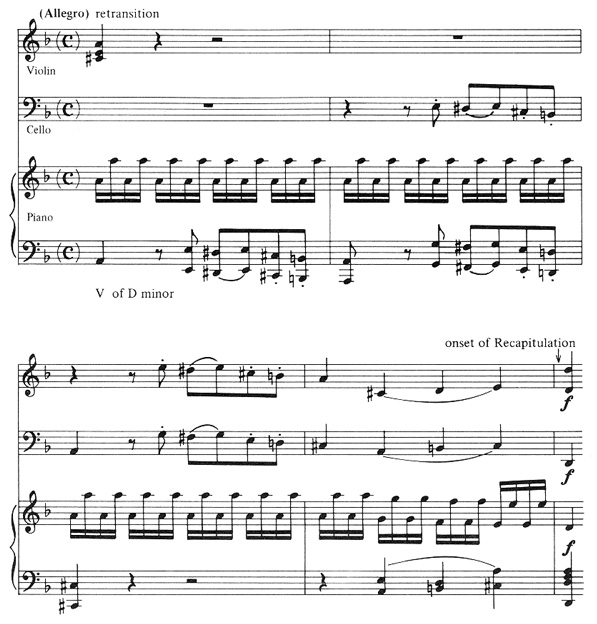
Retransitions dependent on elements of the first tonal area alone frequently occur when the two areas are thematically independent of each other. Generally such retransitions project some aspect of the first theme, which may either reappear intact or undergo varying degrees of fragmentation. Sometimes, for instance, Mozart initiates retransition by means of a false reprise. Usually a false reprise commencing in the tonic reproduces only a limited portion of the opening theme, so that true Recapitulation will not seem to begin prematurely. On the other hand, a larger segment of the first thematic group may evolve if the false reprise appears at a level other than the tonic.
More common than the false reprise among Mozart's sonata movements is the retransition that recalls only the head motive, rather than entire phrases, of the first thematic group. Such a retransition may extend the head motive of the first theme either by sequence or by imitation or by a combination of these techniques. In rare instances, a retransitional passage derived from the first tonal area may completely exclude the head motive of the first thematic group in favor of a less prominent fragment.
Retransitions dependent on the second tonal area are less common than those oriented toward the first area. To some extent, this fact may be explained by the retransitional position within the sonata design. Unlike the return of the first area, the recall of the second area is not in direct succession to the retransition and hence is less likely to supply the prevalent material therein.
Most of Mozart's retransitions relate directly to one or more portions of the Exposition and Recapitulation, quoting elements either from one or both of the principal tonal areas or from a transitional section, Yet occasionally a retransition may incorporate material with no overt tie to any part of the movement before or after the Development section. Generally, in such cases, a new theme emerges toward the close of the Development and subsequently launches the retransition, Under these circumstances, the retransition may embellish the closing material of the Development section in somewhat the same way that earlier segments of the Development elaborate the material of the Exposition. Charles Rosen has identified this structural pattern as "finale sonata form"—perhaps a partial misnomer, since this type of design appears in first and middle movements as well as in finales.12
* * *
Thus Mozart's transitional and retransitional passages offer a great diversity of tonal, motivic, and structural patterns. Amid this diversity, nevertheless, three conditions are generally present:
(1) Most transitions and retransitions create tonal tension, which resolves at least temporarily with the arrival of the next structural element. Tension of this nature may involve either full modulation from one key to another or revitalization of the existing key by a series of transient modulations.
(2) Transitional and retransitional materials usually relate to at least one other portion of the design. These materials may derive from one of the principal thematic groups or from supplementary elements. In exceptional cases, bridge materials of minimal significance may bear no direct relationship to the rest of the movement.
(3) Most transitions and retransitions are continuously composed, ranging from insignificant figuration to substantive enlargement by sequence and/or imitation. Phrase and period constructions are extremely uncommon, since they tend to produce structural autonomy—a quality, as noted earlier, which is detrimental to the function of transition or retransition.
Within his bridge passages, Mozart often reveals his most daring modulations, his most intricate textures, and his most resourceful elaborations. In many respects, then, these passages display the most progressive elements of his compositional style, but always within the Classic context of clarity, order, and balance.
1William S. Newman, The Sonata in the Classic Era, 3rd ed. (New York: Norton, 1983), 19-25. Newman examines various definitions of "sonata" given by Classic composers and theorists, and concludes that very few of these definitions "say enough to be of real consequence."
2Charles Rosen, The Classical Style: Haydn, Mozart, Beethoven (New York: Norton, 1972), 30. According to Rosen, Czerny claimed around 1840 that he was the first to describe sonata form.
3Donald Francis Tovey, The Forms of Music, originally published in 1944 by Oxford University Press as "Musical Articles from the Encyclopaedia Britannica" (Cleveland and New York: World, 1956), 214. Tovey found J.C. Bach, who "had a great influence on the boy Mozart," to be "the first composer to lay a dramatic emphasis on the transition between his first and his second group." For further information concerning J.C. Bach's influence on Mozart, see Alfred Einstein, Mozart: His Character, His Work, trans. Arthur Mendel and Nathan Broder (New York: Oxford University Press, 1962), 218-20.
4Louise Cuyler, The Symphony (New York: Harcourt Brace Jovanovich, 1973), 29-30. Cuyler's description of Haydn's use of this construction in symphonic literature applies equally to some of Mozart's sonata designs: "Most commonly, the opening motive of Area II was patterned on that of Area I but always, of course, with appropriate change of key. . . . Not infrequently, however, a new thematic idea follows the recalled material, so that Area II acquires its own distinctive theme to balance Area I."
5Hans T. David discusses this point briefly in his essay "Mozartean Modulations," in The Creative World of Mozart, ed. Paul Henry Lang (New York: Norton, 1963), 64. If presented without any modulation, David observes, "the recapitulation contained less action and therefore was less interesting than the exposition. . . . [Mozart's] recapitulations are mostly close replicas of the exposition. Yet he invariably managed to outdo the modulatory effect within the exposition by an elaborate counter-modulation in the recapitulation." Such "counter-modulation" may explain in part Mozart's tendency to enlarge the transition belonging to the Recapitulation.
6See Cuyler, 111-12, for a brief discussion of this procedure in Brahms's symphonic movements.
7In the subsequent comparison of transitions within this movement, I have relied on the analysis proposed by Arnold Schoenberg in Structural Functions of Harmony, rev. ed., ed. Leonard Stein (New York: Norton, 1954), 143-44.
8Charles Rosen designates such enlarged transitions within the Recapitulation as "secondary development sections." See in particular his Sonata Forms (New York: Norton, 1980), 106-10. According to Rosen, a secondary development "may use some of the material from the bridge, or from a modulating passage of the exposition, although this is by no means a general rule."
9For a summary of tonality within nineteenth-century sonata form, see William S. Newman, The Sonata Since Beethoven, 3rd ed. (New York: Norton, 1983), 151-53. "As the harmonic progressions and passing modulations grew more colorful and remote, especially near the [Romantic] era's end," states Newman, "the broader shifts in the tonality became increasingly dim and ineffectual as structural landmarks."
10For a thoughtful discussion of this point, see Beth Shamgar, "On Locating the Retransition in Classic Sonata Form," Music Review 42 (1981):130-43.
11For a late eighteenth-century perspective on tonal schemes within retransitions in Mozart's concerted sonata-type movements, see Shelley Davis, "H.C. Koch, the Classic Concerto, and the Sonata-Form Retransition," Journal of Musicology 2 (1983):45-61.
12Rosen, Classical Style, 100. The first movement of Mozart's Violin Sonata in B-flat major (K. 454), for example, illustrates the so-called "finale sonata form." Commencing within the Development at measure 75, eighth-note triplets are sounded for the first time by the piano, and are continued in an imitative dialogue between piano and violin during the initial stage of retransition. With the approach of the Recapitulation, these triplets disappear for the remainder of the movement.
